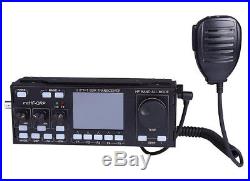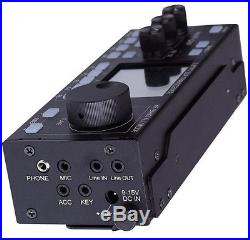





Latest RS-918 SDR HF tranciever, small enough to fit in a coat pocket. Three weeks-PLUS to as much as six weeks from ALL of the other sellers, as they are all in China. My quest is to offer the radios from a USA-based retailer, so I’d be able to deliver the radios with two three? Here are some good videos on this unit. New user group started 2-3-2018 for the new RS-918 HF SDR Transceiver. This user group has one “rule:” BE NICE. Product Description: – HF QRP Transceiver, attach battery 12v and ANT and then QSO! – DC IN: 9-13V Max:3A – Output POWER:10W (44dbm) MAX:15W – Transmit: 160, 80, 60, 40, 30, 20, 17, 15, 12 and 10 meter amateur bands. Receive: 3.5-30 MHz nominal including general coverage, 0.8-32 MHz at reduced specifications. Sensivity/bandwidth Better than -108 dBm (0.89uV) in a 2.3 kHz bandwidth Better than -120 dBm (0.22uV) in a 300 Hz bandwidth Technical Specifications: Because this is a software-defined radio and due to ongoing modifications/improvements of the software and hardware, the specifications continue to improve. Receiver sensitivity for 10dB S/N, CCITT filtering, taken at 28.3 MHz. Better than -111 dBm (0.6uV) in a 2.3 kHz bandwidth Better than -126 dBm (0.11uV) in a 300 Hz bandwidth. Better than -108 dBm (0.89uV) in a 2.3 kHz bandwidth Better than -120 dBm (0.22uV) in a 300 Hz bandwidth The above specifications are for a receiver on which the published sensitivity modifications are performed. Frequency coverage: – Transmit: 160,80,60,40,30,20,17,15,12 and 10 meter amateur bands. Note: The ability of the Si570 to tune the radio below 2.5 MHz is not guaranteed in its specifications, but most units have enough range to tune just below 1.8 Mhz. Maybe there are some small gaps where LO does not work – if it works, it works fine. Indicator is the color of the frequency digits: – White: fully working – Yellow: mostly working, maybe there are some small gaps – Red: not working Spectral Display Modes. This is a spectrum analyzer with the vertical divisions representing userdefinable amplitude variations of 5,7.5,10,15, 20,1 S-Unit (6dB), 2 S-Units (12dB) or 3 S-Units. The baseline (“reference level”) of the analyzer is automatically adjusted so that the signals within the displayed passband best-fit the dynamic range selected by the userselected dB/division. A graticule along the bottom of the display indicates the approximate frequency of the signal being displayed over a width of +/- 24 kHz. As with the spectrum scope, the frequency is displayed along the “x” axis but the signal strength is implied by the displayed color. The newest signals are displayed along the bottom of the screen, but as new readings arrive, the representations of the older signals are shifted upwards giving an ephemeral time record of recent activity on nearby frequencies. There are several options for color “palettes” that range from simple grayscale to “cold-hot” to “rainbow” to represent weak to strong signals. There is also a “Magnify” mode. For both the Spectrum Scope and Waterfall Display mode that provides 2x magnification, reducing the visible spectral width to just +/-12 kHz (24 kHz total). Continuous “Clip Warning”occurs above approximately -28 dBm and actual A/D clipping and distortion occurs at and above approximately -18 dBm for signals +/- the local oscillator frequency and higher for signals outside this range. Transmitter power output: <=10 Watts, typical, linear. Modifications may be made to increase this: Follow the discussions in the Yahoo group. Frequency stability: +/- 30 Hz at 14 MHz over the range of 10 to 35 C, ambient with the transceiver in the case or better with the TCXO active. It can be much better than this. FM options: Carrier (ultrasonic) squelch, subaudible tone encoding and decoding, tone burst ("whistle up") generation, "narrow" (+/-2.5 kHz) and "wide" (+/-5 kHz) deviation and the selection of 7.2,10,12 or 15 kHz pre-detection receive bandwidths. FM sensitivity for 12 dB SINAD, CCITT filtering: 7.2 kHz BW filter: -103.7 dBm (1.46uV) with 1 kHz tone at +/-1.5 kHz 10 kHz BW filter: -102.1 dBm (1.75uV) with 1 kHz tone at +/-1.5 kHz 10 kHz BW filter: -104.0 dBm (1.41uV) with 1 kHz tone at +/- 3kHz 12 kHz BW filter: -102.7 dBm (1.63uV) with 1 kHz tone at +/- 3kHz 15 kHz BW filter: -99dBm dBm (2.50uV) with 1 kHz tone at +/- 3 kHz CW mode receive/transmit and frequency display details: Nine modes of CW display/shifting are available to emulate the various makes of radios and suit the user's taste, ranging from no shifting, display-only shifting, display and LO shifting and manual or automatic LSB/USB shifting. In CW mode "CW-L" or "CW-U" is displayed depending on whether LSB or USB is being used for reception. CW Speed range: 5-48 WPM. Available audio filter bandwidths in this firmware version: 300 Hz, 500 Hz, 1.8 kHz, 2.3 kHz, 3.6 kHz, with a "wide" filter of 5, 6, 7.5 or 10 kHz being selectable in all modes except FM, where the filtering is done prior to demodulation as noted above. All filters are softwaredefined and additional bandwidths could be made available. Filters can be used as BPF or as LPF selectable in main menu. DSP Filtering Capability: Noise reduction and Automatic Notch Filter with adjustable parameters. Notch filtering is disabled in CW mode for obvious reasons! Or when using a "wide" receive bandwidth. Devel-branch: Because NR activation leads to instability of mcHF it is disabled by default. If you want to use it (and risk instabilities in various scenarios) you can activate NR in config menu last item. Setting will NOT BE STORED and must be activated after every powering on. When NR issues are fixed and NR will be improved this function will be obsolete. S-Meter calibration: "Industry Standard" IARU Region 1, Technical recommendation R. Units above S-9 are in dB units, as noted. External audio input/output connections: "Line In" and "Line Out" audio ports, and a "PTT" (Push-to-Talk) are provided via 3.5mm connectors to allow the connection to an external device. (devel-branch only): There is CAT function and audio-in and out also as IQ in and out via USB available. Setting of input is in main menu #60 or via long-press of M3. Line out signal levels: Nominal 1 volt peak-peak, maximum when AGC is operating. Line in signal levels: Nominal 0.1 -> 1.0 volt peak-peak, adjustable using the “Line Input Gain” settings. Transmit ALC type: Look-ahead gain compressor with both pre-set and available “custom” settings. 410 mA on 40 meters and below at 13.0 volts, approx. 440 mA on 10 meters, minimum volume, maximum display brightness. The selection of minimum display brightness can reduce this by 40-60mA. The modification to the PA drivers to switch off bias when not in TX mode can reduce this by a further 30-60 mA. Power off: <5 mA if the PA driver bias modification is performed. If this modification is not performed it is recommended that power be disconnected from the transceiver as the PA driver transistors will be biased on even when the power is turned off, causing 30-60 mA of standing current. With modification RF-04-: -010 from German mcHF Project Group consumption in power off is <0.5uA. (At 13.0 volts power supply): At full power around 3A; At 10W around 2.5A Packing List: - 1 x RS-918 HF SDR Transceiver - 1 x PL-918 DC Power Cable - 1 x HM-918 Hand Microphone - 1 x Wrench - 1 x BNC To SO239 Convertor - 1 x User Manual. The item "(USA DEALER!) 2-DAY SHIP NEW in box Recent RS-918 SDR HF Transceiver 10 watt" is in sale since Saturday, February 17, 2018. This item is in the category "Consumer Electronics\Radio Communication\Ham, Amateur Radio\Ham Radio Transceivers". The seller is "mikes3" and is located in Hampton, Minnesota. This item can be shipped to United States.
- Brand: Unbranded/Generic
- Supported Modes: AM
- Model: RS-918
- Band Plan: 10m – 80m
- Type: Portable/Handheld
- Country/Region of Manufacture: United States
- Frequency Band(s): HF
- Bundle Listing: No
- MPN: Does Not Apply

